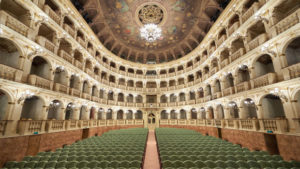
Behind the scenes at Bologna’s Teatre Comunale d&b audio upgrade
Historic Italian opera house Teatro Comunale has undergone a major audio upgrade. Mike Clark takes a look behind the scenes…
According to one’s interests, the Italian city of Bologna is best known for its cuisine, the fact that it hosts Europe’s oldest university or its 38 kilometres of porticoes. But, it’s also the home of an important opera theatre, the Teatro Comunale, inaugurated in 1763 with the first performance of Gluck’s Triumph of Cloelia. It was the first Italian theatre to stage numerous Wagner operas and Giuseppe Verdi was in the audience at the first production of Lohengrin.
The venue, which has hosted singers of the calibre of Gigli, Di Stefano, Tebaldi, Del Monaco and Pavarotti, recently underwent an upgrade to its audio facilities, with the installation of a d&b audiotechnik sound system and a Midas Pro1 console.
The system was designed by Massimo Carli of MediaCare AudioVisual (San Giuseppe – Ferrara), using d&b ArrayCalc, and the company also carried out the installation.
Carli explains: “The theatre wanted a PA with a low visual impact, that was able to ensure perfect coverage of the 850-capacity room, including its four tiers of boxes. When I suggested column speakers, the sound engineers weren’t convinced that they’d be up to the job. However, I’ve specified d&b’s 24C for some time and was certain of the outcome of an A/B test, so suggested an onsite demo, setting up a 24C system with E15X-SUBs and anther point source system. The results convinced the audio team and management that the column system was the right choice and clinched the deal.”
Until recently, the only sound reinforcement at the theatre was a quartet of small enclosures installed on the cornice of the second tier of boxes. In the main room there’s now a set-up comprising four 24C, a pair for the stalls, the other for the first tier of boxes. There are four additional 24C, each with a 24C-E column extension (providing six additional 4” drivers), for the other boxes, supported by two compact but punchy E15X-SUB subwoofers. Goso chose these after considering the crossover frequency of the subs, which support the main speaker to approximately 140Hz.
“When necessary, I can boost the bottom end with a pair of E18, but, since the E15X have plenty of SPL, I can give them a few more dB of EQ on the low frequencies and avoid using the ‘big’ subs,” Carli added.
“The 24C and 24CE are really splendid as far as sound is concerned. I was immediately struck by their natural timbre, particularly on the high frequencies. They sound more like a good hi-fi system, rather than a PA, and, thanks to their slim lines and custom RAL colour finish, merge perfectly with the theatre’s decor.”
As far as amps are concerned, there’s a d&b 30D for the two E15X and the two E18 when used, with a cable run arriving on stage, for use for internal amplification (for example the organ in Tosca) or effects such as thunder, cannon shots, etc. Then there are three 10D, as each 24C or 24C+CE has its own dedicated channel. The 24CE require this for impedance reasons, whereas the 24Cs (which theoretically need one channel for each pair of enclosures) are powered individually, since, for installation reasons, they must be aligned with a delay, so couldn’t share a channel. Two 10D are used for the main system, while a third handles the stage where, for monitoring, Goso chose a pair of 16C, positioned in the fly towers, and two 12S half-way upstage, which, as well as a foldback from the orchestra, are often used for effects.
New gear was also installed in the theatre’s two foyers, which host rehearsals, conferences, small modern music concerts, DJ sets and other events.
In the Respighi foyer, a 10D powers a pair of 24C, leaving two channels free in the event of a sub or monitors being required. In the Rossini foyer, another 10D is used with a quartet of 8S and an E15X-SUB. Each foyer has a Soundcraft Ui16, for conferences or small sets and an extra Yamaha console is deployed for larger projects.
Goso concludes: “The main room’s signal routing is entrusted to a d&b DS10 network bridge, which handles the conversion of the signals on the Dante network to AES-EBU for the amps. In the rack along with the amps and DS10 there are two Focusrite units, a RedNet2 and a RedNet4, the latter used for the ‘most important’ microphones. A Midas DL151, providing 24 mic preamps, is connected directly to the Midas PRO1. These channels are available on the network thanks to a Klark Teknik DN9650 bridge, which also converts the Dante signal coming from the Rednet units to SuperMac for our Midas PRO1, where we record with Pro-Tools 12 and monitor with two Unity Audio Boulder MKII.”
Source: mi-pro.co.uk



